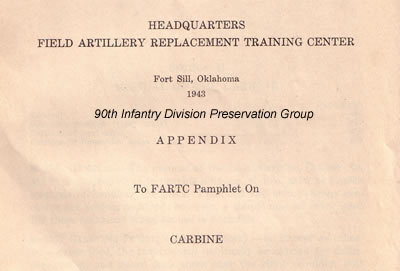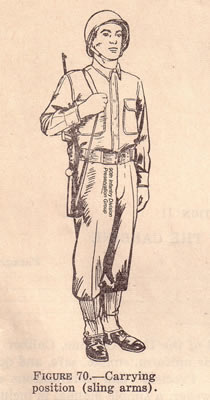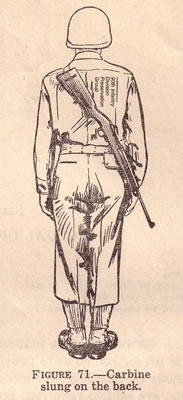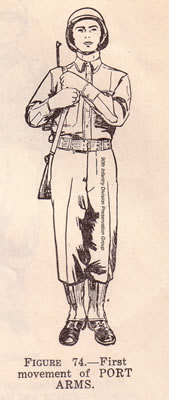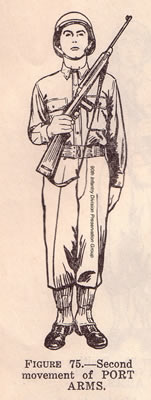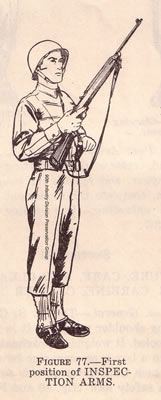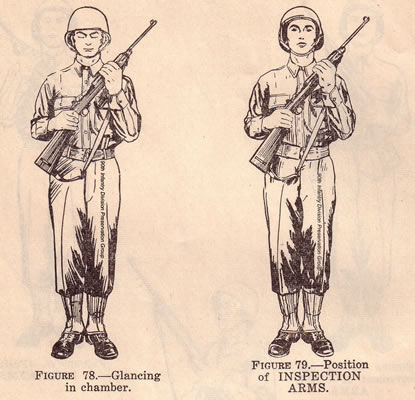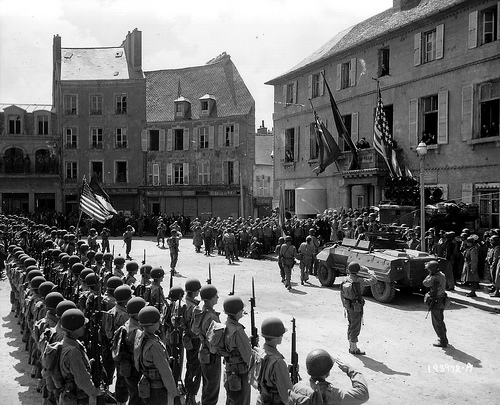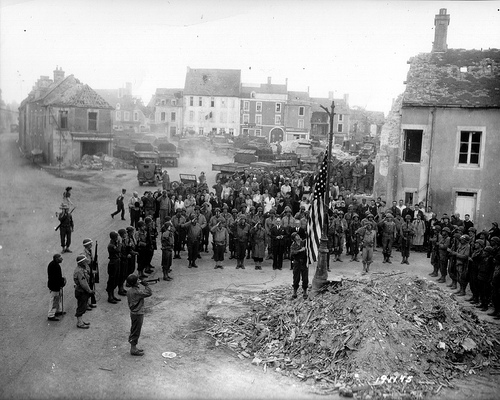M1 Carbine Manual of Arms
Date: 1/23/2010
Transcribed by: Chris Guska
The M1 Carbine is somewhat misunderstood within the reenacting community - one often finds reenactors in formation doing various parts of rifle drill, often at awkward angles due to the weapon's short stature. It is easy to guess that the lack of concrete knowledge stems from its omission from the common manuals referenced by reenactors. What is the correct Manual of Arms for the M1 Carbine? The question can be answered, but it requires an understanding of wartime Army doctrine as Soldiers would have known it.
FM 23-7 - US Carbine, Caliber 30, M1 both the 1942 and 1944 editions make absolutely no mention of any Manual of Arms (MOA) for the Carbine. On top of this, the wartime version of FM 21-100, the Soldiers Handbook, was actually written before the Carbine even existed. No surprise, there's no Manual of Arms for the Carbine to be found there, either. These three manuals are the only official texts where an army wide regulation would be found regarding MOA.
Does this mean that there was no guidance? Not at all. The Carbine was a brand new weapon, but the existing Soldier's Handbook had an "escape clause":
"Weapons such as the automatic rifle, light machine gun, light mortar, etc., which have no manual of arms are slung from the right shoulder at the command of execution, ARMS, of 1. RIGHT SHOULDER, 2. ARMS. They are kept slung until the command REST or AT EASE. In long halts at attention, the men carrying such equipment may be directed to "unsling arms."
What does this mean? Three letters, "etc.", denote that this is a catchall phrase. For ANY WEAPON, if there was no published Manual of Arms, the only authorized drill was essentially to sling or unsling arms. Being an entirely new weapon, the Carbine was firmly in this category.
But wait, there's more. It seems that many First Sergeants and Company Commanders found themselves in charge of entire formations armed with nothing else but the little Carbine. Further guidance was needed.
Some Army organizations did publish instructions and illustrations for the "Manual of the Carbine" - which we located a copy of within the 81mm Mortar Handbook published by the Infantry Journal in 1942, in addition to an appendix pamphlet from the Field Artillery Replacement Training Center (FARTC) - dated 1943 which we have scanned and placed within this article . Both sources have are verbatim with regards to Text and Illustrations of the "Manual of the Carbine".
Below, for your reading pleasure, is the only wartime guidance for the "Manual of the Carbine" likely to be seen for some time:
We have transcribed the manual for your convenience and scanned the original illustrations. I have added additional notes and commentary in BLUE.
MANUAL OF THE CARBINE
General. -
The manual of the U.S. Carbine, Caliber .30, M1 is prescribed so as to provide uniform, simple, safe, and quick methods of handling the piece. Precision and simultaneous execution are seldom required; however, a simple manual is included for those occasions when its use is desirable.
Carrying Position ( Sling Arms). -
-a. Except as otherwise prescribed, the carbine will habitually be carried for drills, ceremonies, and guard duty slung over the right shoulder, butt down, barrel to the rear, right hand grasping the sling, hand in front of armpit. (Figure 1). The magazine will be inserted in the receiver for ceremonies and guard duty only.
When troops are at ease, the carbine is kept slung unless otherwise ordered. When troops are at rest, the carbine may be un slung and held in any desired position.
Recap 1: The gun is slung at all times - except when you are at "REST". At "REST" you can hold it however you want. NO MAGAZINE, unless specifically ordered.
In executing Attention, the carrying position is assumed. Parade rest and the Right-hand salute are executed in the normal manner, as without arms, after releasing the grasp of the right hand from the sling.
Recap 2: At Atttention, hold the sling with your right hand in front of your armpit. Left hand to the side.
Recap 3: Parade Rest and Salutes are done as if you didnt even have a weapon. Leave it slung and proceed as normal.
-b. For dismounted marches or field exercises, the carbine may be slung over either shoulder, slung on the back with sling over left shoulder with muzzle down, or carried in the holster.
The magazine will be inserted in the receiver only when specifically ordered.
Position of Port Arms. -
Executed at the command: 1. PORT, 2. ARMS. The carbine being slung, at the command of execution, grasp the sling with the left hand above the right, lifting the piece from the shoulder and at the same time withdrawing the right arm from between the piece and sling. Grasp the small of the stock with the right hand, bringing the piece to a vertical plane parallel to and about 4 inches in front of the center of the body, barrel extending upward to the left at an angle of 45 degrees. With the left hand grasp the hand guard about 3 inches below the upper band. The position of Port Arms is not assumed when the carbine is carried in the holster. Port Arms with the carbine is not executed as part of the manual of arms with the rifle.
Recap 4: Execute this when you would with an M1 or 03.
Note 1: "Port Arms with the carbine is not executed as part of the manual of arms with the rifle. " - While this seems to be a contradictory statement to the above text, we interpret this as a reminder not to get ahead of the published reg. In other words, "no right/left shoulder arms", no "order arms" - only what was included in this reg was permissible.
Position of Inspection Arms. -
a. Execution. - Executed at the command: 1. INSPECTION, 2. ARMS; or when other members of the command are executing the manual of the pistol, at the command: 1. INSPECTION, 2. PISTOL. The carbine being slung, at the command of execution, grasp the sling with left hand above the right, lifting the piece from the shoulder and at the same time withdrawing the right arm from between the piece and sling. Grasp the small of the stock with the right hand, resting the butt of the piece just in front of the right hip, barrel elevated at an angle of 45 degrees, muzzle to the front
Press the magazine lock to the left with the forefinger of the right hand and, at the same time, withdraw the magazine from the receiver with the left hand, inserting it between the body and belt in front of the left hip. Assume the position of Port Arms. With the forefinger of the right hand, pull the operating slide all the way back and press down on the operating slide catch with the right thumb, locking the operating slide in its rear position; re grasp the small of the stock and at the same time lower the head and eyes sufficiently to glance into the chamber.
Having found the chamber empty, or having emptied it, raise the head and eyes to the front. Inspection Arms with the carbine is not executed as part of the manual of arms with the rifle.
Recap 5: Execute this when you would with an M1 or 03.
b. Being at Inspection Arms. -
(1) To return to Sling Arms.
Executed at the command: 1. ORDER (RIGHT SHOULDER), 2. ARMS, or 1. RETURN, 2. PISTOL. At the preparatory command, release the operating slide by pulling the operating handle slightly to the rear with the right forefinger and allowing the slide to go forward; pull the trigger, and replace the magazine. At the command of execution, re sling the carbine over the right shoulder and resume the position of Attention.
(2) To execute Port Arms.
- 1. PORT, 2. ARMS. At the preparatory command, release the operating slide as described above, pull the trigger, and replace the magazine. At the command of execution, complete the movement.
c. Loading and unloading. - For loading and unloading the carbine, see FM 23-7.
End
Note 2: While these instructions were in various print publications, individual commanders sometimes took it upon themselves to adjust things to their liking. This is evidenced by original photographs of soldiers doing things with the Carbine while in formation that are not described in the above publication. These variances can be contradictory to the above publication. On the other hand, we have yet to find a wartime image of the M1 Carbine at "order arms". We'd love to see it.In the photo below, we can see soldiers armed with the Carbine executing Present Arms as outlined per above - with exception of 2 Carbines with muzzle down. As an easter egg, check out all the FLAT 28 Packs on these guys...
In the photo below, we can see soldiers executing Present Arms with the Carbine as the would with the Rifle - contrary to what is specified above. As an additional note, there is a Sergeant executing Present Arms with a Thompson, as would be done with the Rifle. On the left is a MP not following the Manual of the Rifle.
Summary:
Here's a quick reference guide of what to do on the following commands:
ATTENTION Same as Sling Arms. Carbine over your RIGHT shoudler, sling held with RIGHT hand in front of armpit. Left hand along left leg. PARADE REST Come to position of Parade Rest, as if you were unarmed. Carbine remains slung. REST Stay in place as you would at the command Rest; you are free to hold the Carbine as you wish. SLING ARMS Sling the Carbine over your RIGHT shoulder as described above. PORT ARMS Come to position of Port Arms as described above. INSPECTION ARMS Come to position of Inspection Arms as described above.
RIGHT SHOULDER ARMS See Sling Arms LEFT SHOULDER ARMS See Sling Arms ORDER ARMS See Sling Arms TRAIL ARMS See Sling Arms PRESENT ARMS Execute hand salute as if unarmed. RIFLE SALUTE Execute hand salute as if unarmed. LOCK PIECES From Inspection Arms - Release slide and bolt forward, apply safety. UNLOCK PIECES From Inspection Arms - Release slide and bolt forward, pull trigger.
90th IDPG Research



